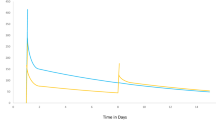Summary
Two open-label studies were conducted to assess the serum, urine, polymorphonuclear (PMN) and red blood cell (RBC) pharmacokinetics of a 5-day course (1500mg total) of oral azithromycin. Inflammatory and non-inflammatory blisters were also induced to study the propensity of azithromycin to preferentially concentrate at a model infection site. 14 subjects participated in the two studies and tolerated azithromycin and the study methods well. Comodelling of the serum and urine data demonstrated very extensive distribution into peripheral compartments, low renal clearance (7% of total oral clearance) and an extended terminal half-life (79 hours). PMN leucocyte concentrations peaked at 119 mg/L following the final dose and remained above 60 mg/L 7 days after the final dose. The ratio of blister to serum AUCs was significantly higher in inflammatory (2.2) vs non-inflammatory (1.2) blisters (p < 0.02). The extensive uptake of azithromycin into PMNs coupled with the accumulation of azithromycin into an inflammatory compartment (e.g. infection site) support the hypothesis that PMN leucocytes laden with azithromycin migrate to sites of inflammation, thereby enhancing local concentrations. These studies further demonstrate the unique pharmacokinetic properties of azithromycin and its preferential delivery by phagocytes to the site of infection.
Similar content being viewed by others
References
Ballow CH, Amsden GW. Azithromycin: the first azalide antibiotic. Ann Pharmacother 1992; 26: 1253–61
Foulds G, Johnson RB. Selection of dose regimens of azithromycin. J Antimicrob Chemother 1993; 31Suppl. E: 39–50
Foulds G, Shepard RM, Johnson RB. The pharmacokinetics of azithromycin in human serum and tissues. J Antimicrob Chemother 1990; 25Suppl. A: 73–82
Gardner MJ, Ronfeld RA. Interpretation/characterization of the pharmacokinetics of azithromycin in man [abstract 407]. Program and Abstracts of 8th Mediterranean Congress of Chemotherapy. Athens: May 24-29, 1997
Glaude RP, Bright GM, Issacson RI, et al. In vitro and in vivo uptake of azithromycin (CP-62, 993) by phagocytic cells: Possible mechanism of delivery and release at sites of infection. Antimicrob Agents Chemother 1989; 33: 277–82
Olsen KM, San Pedro GS, Gann LP, et al. Intrapulmonary pharmacokinetics of azithromycin in healthy volunteers given five oral doses. Antimicrob Agents Chemother 1996; 40: 2852–5
Wildfeuer A, Laufen H, Muller-Wening D, et al. Interaction of azithromycin and human phagocytic cells. Arzneimittel Forschung 1990; 39: 755–8
Gladue RP, Snider ME. Intracellular accumulation of azithromycin by cultured human fibroblasts. Antimicrob Agents Chemother 1990; 34: 1056–60
Freeman CD, Nightingale CH, Nicolau DP, et al. Intracellular and extracellular penetration of azithromycin into inflammatory and non-inflammatory blister fluid. Antimicrob Agents Chemother 1994; 38: 2449–51
Retsema JA, Bergeron JM, Girard D, et al. Preferential concentration of azithromycin in an infected mouse thigh model. J Antimicrob Chemother 1993; 31Suppl. E: 5–16
Jelliffe RW, Jelliffe AM. A computer program for estimation of creatinine clearance from unstable serum creatinine levels, age, sex, and weight. Math Bio Sci 1972; 14: 17–24
Koga H. High-performace liquid chromatography measurement of antimicrobial concentrations in polymorphonuclear leukocytes. Antimicrob Agents Chemother 1987; 31: 1904–8
D'Argenio DZ, Schumitzky A. ADAPT II users guide. Bio-medical simulations resource. Los Angeles: University of Southern California, 1992
Yamaoka K, Nakagawa T, Uno T. Application of Akaike's information criterion (AIC) in the evaluation of linear pharmacokinetic equations. J Pharmacokinet Biopharm 1978; 6: 165–75
Amsden GW, Ballow CH, Forrest A. Comparison of the plasma, urine and blister fluid pharmacokinetics of clarithromycin and azithromycin in normal subjects. Clin Drug Invest 1997; 13: 152–61
Nix DE, Goodwin SD, Peloquin CA, et al. Antibiotic tissue penetration and its relevance: impact of tissue penetration on infection response. Antimicrob Agents Chemother 1991; 35: 1953–9
Conte Jr JE, Golden J, Duncan S, et al. Single-dose intrapulmonary pharmacokinetics of azithromycin, clarithromycin, ciprofloxacin, and cefuroxime in volunteer subjects. Antimicrob Agents Chemother 1996; 40: 1617–22
Patel KB, Xuan D, Tessier PR, et al. Comparison of broncho-pulmonary pharmacokinetics of clarithromycin and azithromycin. Antimicrob Agents Chemother 1996; 40: 2375–9
Author information
Authors and Affiliations
Rights and permissions
About this article
Cite this article
Ballow, C.H., Amsden, G.W., Highet, V.S. et al. Pharmacokinetics of Oral Azithromycin in Serum, Urine, Polymorphonuclear Leucocytes and Inflammatory vs Non-Inflammatory Skin Blisters in Healthy Volunteers. Clin. Drug Investig. 15, 159–167 (1998). https://doi.org/10.2165/00044011-199815020-00009
Published:
Issue Date:
DOI: https://doi.org/10.2165/00044011-199815020-00009




